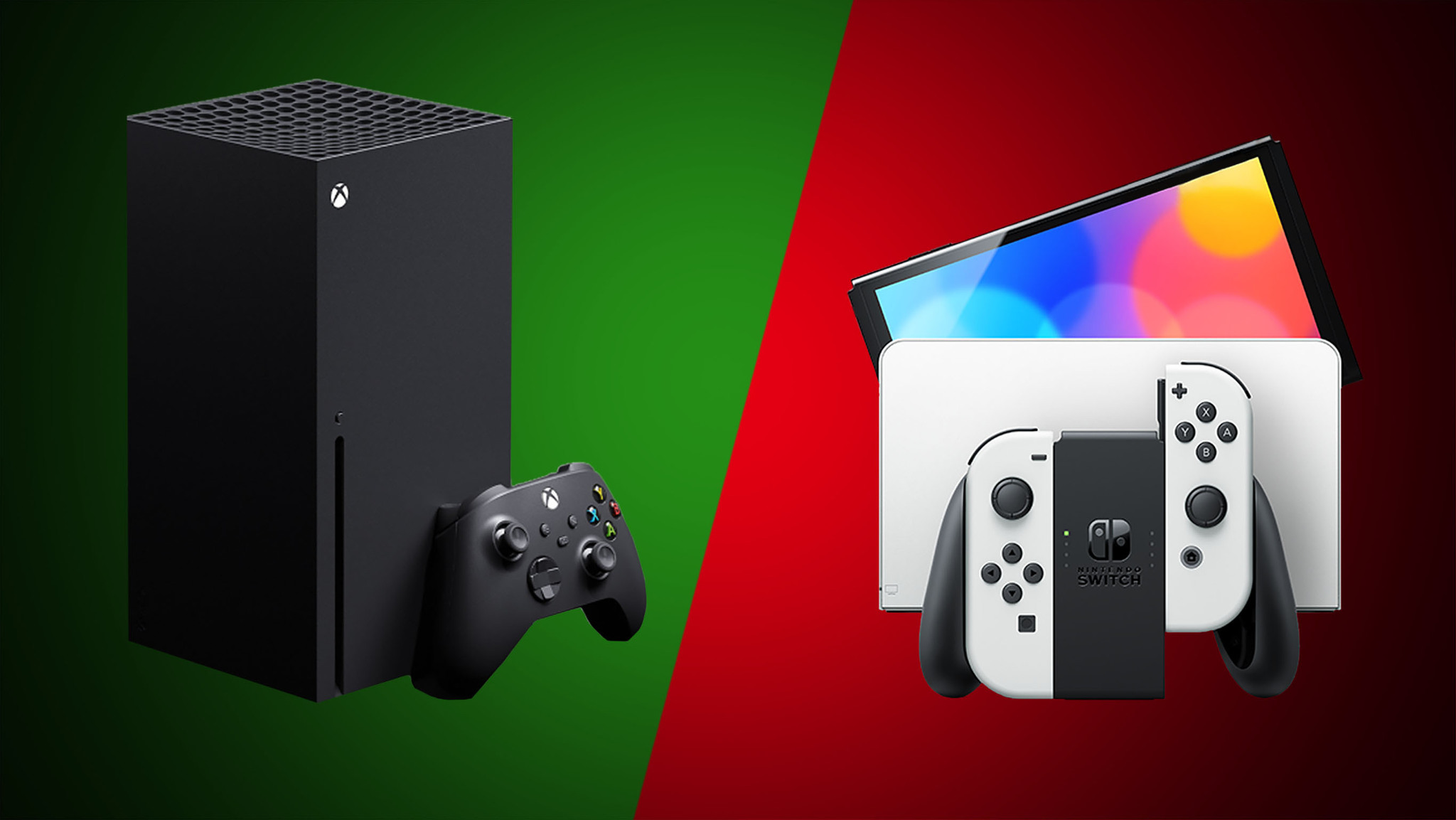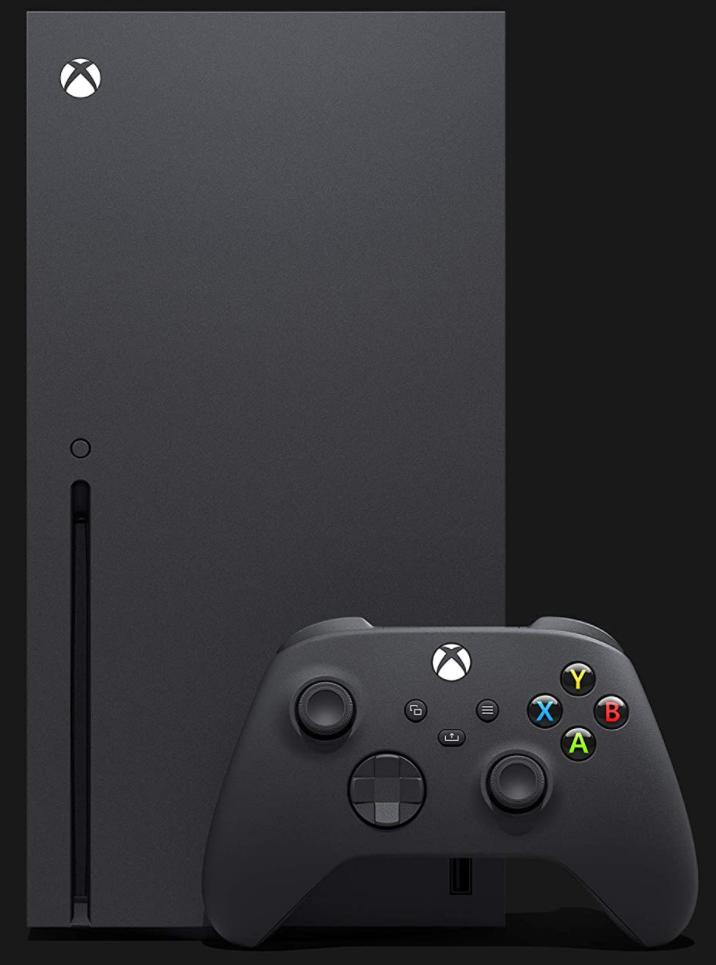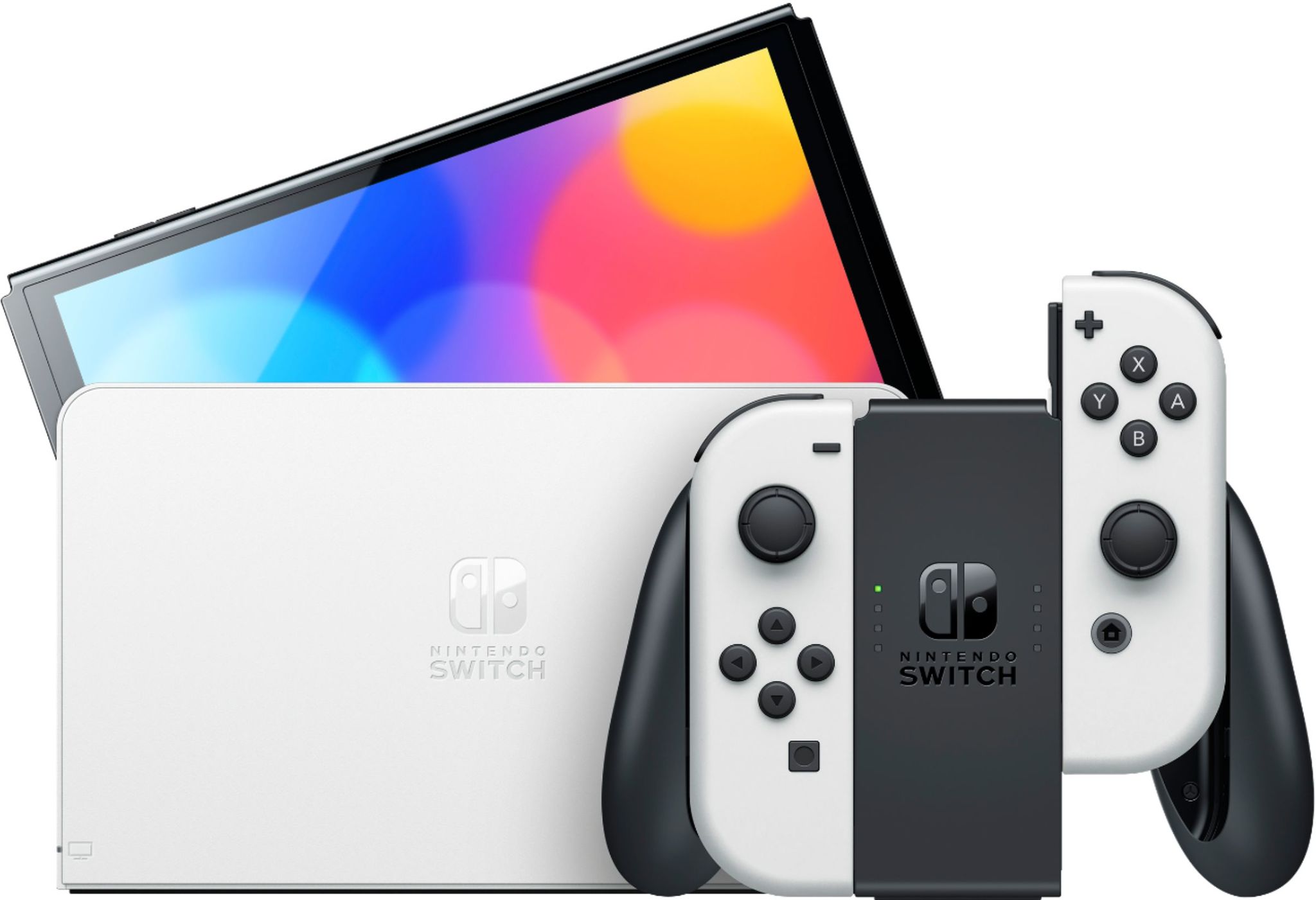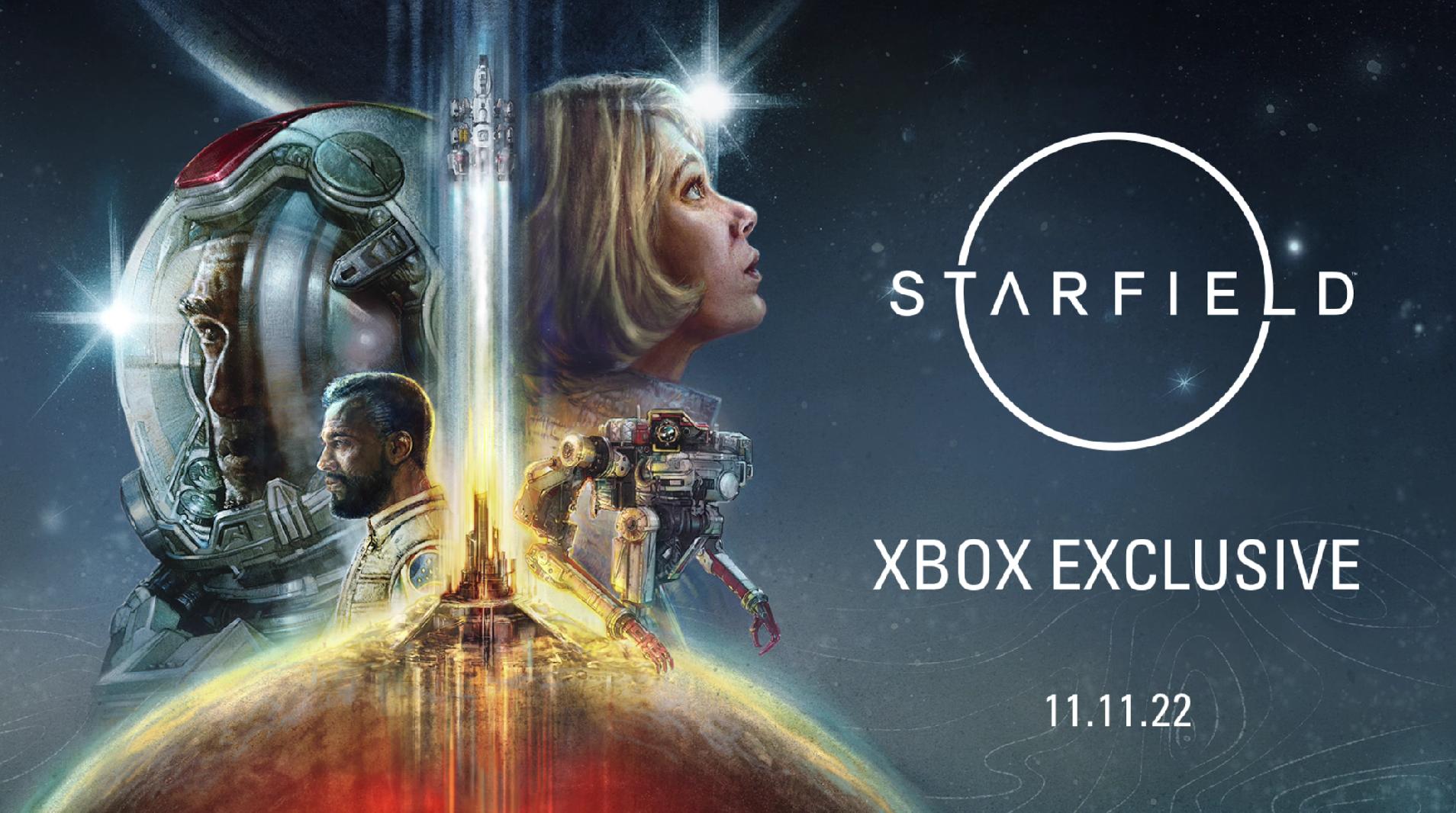Xbox Series X vs. Nintendo Switch OLED: Which should you buy?


Extreme performance
The Xbox Series X is the high-end option from Microsoft's latest gaming consoles. It supports the highest framerates and best graphics available on any console, with a strong lineup of services and games from Xbox first-party and third-party companies alike. It's not portable, however, and it's also pretty expensive.
Pros
- High graphics processing power
- Strong services like Xbox Game Pass
- Exciting lineup of upcoming games
Cons
- More expensive than Nintendo Switch OLED
- Difficult to get

Brighter than ever
The Nintendo Switch OLED is a revision of the existing Switch console, with a slightly larger OLED screen that improves the color and visuals of games. There's a great variety of Nintendo Switch games available. Being a revision means it's still far less powerful than the Xbox Series X and lacks compelling services in the Switch ecosystem.
Pros
- Portable
- Bright OLED screen
- Cheaper than Xbox Series X
- Strong lineup of games
Cons
- Weaker graphics processing power
- Unimpressive services
- Difficult to get
The Xbox Series X and the Nintendo Switch OLED are the latest consoles from Microsoft and Nintendo, respectively. The former heralds an all-new generation while the latter is simply the latest revision of Nintendo's Switch consoles. Both have a wide variety of benefits to consider, which we break down below.
Xbox Series X vs. Nintendo Switch OLED: What's the difference?
One of the most significant differences between the two consoles is the technological specifications, which play to the strengths and weaknesses of the systems. Here are the specs being used to play the best Nintendo Switch games and best Xbox games available.
| Header Cell - Column 0 | Xbox Series X | Nintendo Switch OLED |
|---|---|---|
| Dimensions | 11.8 x 5.9 x 5.9 inches | 4 x 9.5 x 0.55 inches |
| Weight | 9.8lbs | 0.93 lbs |
| Storage | 1TB SSD | 64GB Internal + MicroSD |
| GPU | 12.15 TFLOPS, 52 CUs @ 1.825 GHz Custom RDNA 2 GPU | NVIDIA Custom Tegra processor |
| CPU | 8x Cores @ 3.8 GHz (3.6 GHz w/ SMT) Custom Zen 2 CPU | NVIDIA Custom Tegra processor |
| Memory | 16 GB GDDR6 | 4 GB LPDDR4 SDRAM |
| Resolution | 4K @ 60 FPS, up to 120 FPS | 720p (Undocked) / 1080p (Docked) |
| USB | 3 x USB 3.1 | 1 x USB-C (Console), 3 x USB 2.0 (Dock) |
| Controller | Xbox Series X | S controller | Joy-Cons, Switch Pro controller |
| Backward compatibility | Yes | No |
| Price | $500 | $350 |
It's worth noting that the Xbox Series X is a classic console meant to be connected to one of the best 4K TVs available or a similarly high-quality monitor. Meanwhile, the Nintendo Switch OLED is designed as a hybrid console, like prior Nintendo Switch models, capable of being played in handheld mode or docked and hooked up to a TV.
Xbox Series X vs. Nintendo Switch OLED: What do these differences mean for you?
So, we've broken down everything that sets apart the Xbox Series X and Nintendo Switch OLED, but what do these differences mean? Here's what you should know.
Xbox Series X vs. Nintendo Switch OLED: Tech specs
The main difference in the technical specs of the two consoles is pretty apparent: the Xbox Series X has way more horsepower. The console can play games at 4K, with features like ray-tracing and even 120 FPS games also possible. The NVME SSD storage means that games also load exceptionally quickly.
While the Nintendo Switch OLED is far weaker, running games at a lower resolution and normally a lower framerate, it's also portable. Unlike the Xbox Series X, you can take the Nintendo Switch OLED wherever you want. The OLED screen also means that the color in games "pops" in a way it didn't on other Nintendo Switch models, something that really shows up when comparing the Nintendo Switch OLED with the regular Nintendo Switch.
Xbox Series X vs. Nintendo Switch OLED: Games lineup
Source: Nintendo and Bethesda Softworks
iMore offers spot-on advice and guidance from our team of experts, with decades of Apple device experience to lean on. Learn more with iMore!
The games available on the Xbox Series X and Nintendo Switch OLED are fairly different, and ultimately, both lineups are fairly strong, just appealing to different markets. As a general rule, Microsoft's consoles get better overall third-party support, with more modern games coming from various publishers. Meanwhile, the Nintendo Switch is more hit-or-miss regarding the latest third-party games.
Things really diverge when it comes to the first-party lineup for both systems. Some upcoming and currently available Nintendo Switch games include Metroid Dread, Bayonetta 3, and the sequel to The Legend of Zelda: Breath of the Wild. Nintendo's games tend to be more suitable for all ages, focusing on family-friendly games and different evolutions of long-term Nintendo franchises.
Xbox has recently redoubled its first-party efforts, acquiring numerous studios and a publisher in Bethesda Softworks. This means some of the big highlights coming up and available right now include Halo Infinite, Redfall, and Starfield.
Xbox Series X vs. Nintendo Switch OLED: Services available
Services are another huge difference between the ecosystems in both consoles. Nintendo provides Nintendo Switch Online for $20 a year, granting multiplayer access to online games. It also provides support for Cloud saves in some games, but not all games. Nintendo also offers the Nintendo Switch Online + Expansion Pack for $50 a year, which adds in a library of Nintendo 64 and Sega Genesis games, alongside the Happy Homes DLC for Animal Crossing: New Horizons.
Cloud saves for all games are completely free on Xbox. Meanwhile, Microsoft has made waves with Xbox Game Pass, allowing day-one access to all first-party games for $10 a month. Any game from Xbox Game Studios or Bethesda Softworks is available in the service the same day that it launches. Additionally, many third-party games are added to the service regularly. Xbox Game Pass Ultimate, which is $15 a month, bundles in the EA Play subscription service alongside Xbox Live Gold multiplayer access and Xbox Cloud Gaming.
Frankly, it's just no contest, as Microsoft has stronger services in its ecosystem, with different options depending on what you're most interested in.
Xbox Series X vs. Nintendo Switch OLED: Controllers
The Nintendo Switch OLED uses the same Joy-Con controllers included with the regular Nintendo Switch. It's also compatible with the best Nintendo Switch controllers, like the Nintendo Switch Pro Controller. Meanwhile, the best Xbox controllers consist of the latest Xbox Series X|S controller.
It comes down to personal preference, as both controllers are broadly well-liked by a range of players. Both controllers support capturing screenshots or videos with a similar button and trigger layout. The Joy-Cons, being smaller, are somewhat more uncomfortable for extended periods of play, especially for anyone with larger hands.
Xbox Series X vs. Nintendo Switch OLED: Storage options
For the Nintendo Switch OLED, expansion is pretty simple if you need more storage than the 64 GB internal space that the system comes with. You'll want to grab one of the best Nintendo Switch memory cards, which vary in price but usually are around $37 for 256 GB.
For the Xbox Series X, it's a bit more complicated. You can play backward compatible Xbox One, Xbox 360, and original Xbox games off an external hard drive; however, you need to play Xbox Series X|S games on the console's internal drive since the games need an ultra-fast SSD. The only way to expand this super-fast internal storage is with one of the best Xbox SSDs, the Seagate Expansion Card. This card is expensive, at a price of around $200 for 1 TB.
Xbox Series X vs. Nintendo Switch OLED: Which should you buy?
Ultimately, while the Xbox Series X and Nintendo Switch OLED are in high demand, both cater to very different audiences. The Nintendo Switch OLED is cheaper, with a range of generally more family-oriented games. The Xbox Series X is more expensive, with first-party games available on day one in Xbox Game Pass. You'll need to look at the games available on both systems, then make the call as to which console you're most interested in.
The biggest downside to both is the simple fact that right now, all electronics, especially computing components and consoles, are suffering from severe supply chain issues. As such, if you see an Xbox Series X or a Nintendo Switch OLED in stock, you need to act extremely quickly. Right now, analysts are warning that the chip shortage is expected to last until late 2022, possibly even early 2023. Console stock shouldn't be expected to improve vastly before then.

Highest performance available in consoles
The Xbox Series X delivers the best graphics and highest framerates with ultra-fast loading speeds. With Xbox Game Pass and a renewed focus on first-party content, there's plenty to look forward to. lt's also a dedicated home console, so you can't play it on the go.

Better colors than before
The Nintendo Switch OLED may just be a revision, with the same processing power as prior Switch consoles, but the OLED screen means games look far better than before. There's other improvements too, like better build quality and increased storage.

Samuel Tolbert is a freelance gaming writer who started working for iMore and its sister sites Windows Central and Android Central in July 2019. He handles news, previews, reviews, and exclusive original reporting, and has also been featured on TechRadar.
With a background studying engineering before he shifted his focus to gaming journalism, he's skilled at identifying technical advantages and disadvantages provided by different hardware. If he’s not writing something, he’s off playing video games, spending time with his pets, exercising, or reading. He's also fond of trying to draw things with his iPad.




